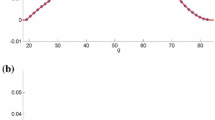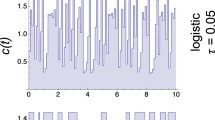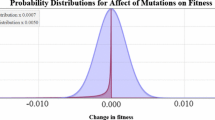Abstract
Proposed here is that an overriding principle of nature governs all population behavior; that a single tenet drives the many regimes observed in nature—exponential-like growth, saturated growth, population decline, population extinction, and oscillatory behavior. The signature of such an all embracing principle is a differential equation which, in a single statement, embraces the entire panoply of observations. In current orthodox theory, this diverse range of population behaviors is described by many different equations—each with its own specific justification. Here, a single equation governing all the regimes is proposed together with the principle from which it derives. The principle is: The effect on the environment of a population’s success is to alter that environment in a way that opposes the success. Experiments are suggested which could validate or refute the theory. Predictions are made about population behaviors.



Similar content being viewed by others
References
Berryman A (2003) On principles, laws and theory in population ecology. Oikos 103:695–701
Blount ZD, Boreland CZ, Lenski RE (2008) Historical contingency and the evolution of a key innovation in an experimental population of Escherichia coli. Proc Natl Acad Sci USA 105:7899–7906
Britton NF (2003) Essential mathematical biology. Springer, London
Carroll SB (2006) The making of the fittest. W.W. Norton, New York
Clutton-Brock TH (ed) (1990) Reproductive success: studies of individual variation in contrasting breeding systems. University of Chicago Press, Chicago
Coulson T, Benton TG, Lundberg P, Dall SRX, Kendall BE, Gaillard J-M (2006) Estimating individual contributions to population growth: evolutionary fitness in ecological time. Proc R Soc B 273:547–555
Darwin C (1859) On the origin of species by means of natural selection. John Murray, London
Fisher RA (1930) The genetical theory of natural selection. Oxford University Press, Oxford
Gilbert SF, Epel D (2009) Ecological developmental biology. Sinauer, Sunderland
Ginzburg LR (1972) The analogies of the “free motion” and “force” concepts in population theory (in Russian). In: Ratner VA (ed) Studies on theoretical genetics. USSR: Academy of Sciences of the USSR, Novosibirsk, pp 65–85
Ginzburg LR (1986) The theory of population dynamics: I. Back to first principles. J Theor Biol 122:385–399
Ginzburg LR (1992) Evolutionary consequences of basic growth equations. Trends Ecol Evol 7:133; further letters, 1993, 8, 68–71
Ginzburg LR, Colyvan M (2004) Ecological orbits. Oxford University Press, Oxford
Ginzburg LR, Inchausti P (1997) Asymmetry of population cycles: abundance-growth representation of hidden causes of ecological dynamics. Oikos 80:435–447
Ginzburg LR, Taneyhill D (1995) Higher growth rate implies shorter cycle, whatever the cause: a reply to Berryman. J Anim Ecol 64:294–295
Jablonka E, Raz G (2009) Transgenerational epigenetic inheritance: prevalence, mechanisms and implications for the study of heredity and evolution. Q Rev Biol 84:131–176
Jones JM (1976) The r-K-selection continuum. Am Nat 110:320–323
Kuno E (1991) Some strange properties of the logistic equation defined with r and K—inherent defects or artifacts. Res Popul Ecol 33:33–39
Kuussaari M, Bommarco R, Heikkinen RK, Helm A, Krauss J, Lindborg R, Öckinger E, Pärtel M, Pino J, Rodà F, Stefanescu C, Teder T, Zobel M, Ingolf Steffan-Dewenter I (2009) Extinction debt: a challenge for biodiversity conservation. Trends Ecol Evol 24:564–571
Lotka AJ (1956) Elements of mathematical biology. Dover, New York
Ma S (2010) Did we miss some evidence of chaos in laboratory insect populations? Popul Ecol. doi:10.1007/s10144-010-0232-7
Malthus T (1798) An essay on the principle of population. J. Johnson, London
Marion JB (1970) Classical dynamics of particles and systems. Academic Press, New York. Green’s Function Method, exibited in Equation 4.83 on page 140
Matis JH, Kiffe TR, van der Werf W, Costamagna AC, Matis TI, Grant WE (2009) Population dynamics models based on cumulative density dependent feedback: a link to the logistic growth curve and a test for symmetry using aphid data. Ecol Model 220:1745–1751
McNamara JM, Houston AI (2009) Integrating function and mechanism. Trends Ecol Evol 24:670–675
Michod RE (1999) Darwinian dynamics: evolutionary transitions in fitness and individuality. Princeton University Press, Princeton
Murray JD (1989) Mathematical biology. Springer, Berlin
Nowak MA (2006) Evolutionary dynamics: exploring the equations of life. Harvard Press, Canada
Okada H, Harada H, Tsukiboshi T, Araki M (2005) Characteristics of Tylencholaimus parvus (Nematoda: Dorylaimida) as a fungivorus nematode. Nematology 7:843–849
Parry GD (1981) The meanings of r- and K-selection. Oecologia 48:260–264
Pelletier F, Garant D, Hendry AP (2009) Eco-evolutionary dynamics. Phil Trans R Soc B 364:1483–1489
Ruokolainen L, Lindéna A, Kaitalaa V, Fowler MS (2009) Ecological and evolutionary dynamics under coloured environmental variation. Trends Ecol Evol 24:555–563
Torres J-L, Pérez-Maqueo O, Equihua M, Torres L (2009) Quantitative assessment of organism–environment couplings. Biol Philos 24:107–117
Turchin P (2003) Complex population dynamics: a theoretical/empirical synthesis. Princeton University Press, Princeton
Turchin P, Wood SN, Ellner SP, Kendall BE, Murdoch WW, Fischlin A, Casas J, McCauley E, Briggs CJ (2003) Dynamical effects of plant quality and parasitism on population cycles of larch budmoth. Ecology 84:1207–1214
Vainstein JH, Rube JM, Vilar JMG (2007) Stochastic population dynamics in turbulent fields. Eur Phys J Special Top 146:177–187
Verhulst P-F (1838) Notice sur la loi que la population poursuit dans son accroissement. Correspondance mathématique et physique 10:113–121
Volterra V (1926) Fluctuations in the abundance of a species considered mathematically. Nature 118:558–560
Author information
Authors and Affiliations
Corresponding author
Rights and permissions
About this article
Cite this article
Chester, M. A Fundamental Principle Governing Populations. Acta Biotheor 60, 289–302 (2012). https://doi.org/10.1007/s10441-012-9160-6
Received:
Accepted:
Published:
Issue Date:
DOI: https://doi.org/10.1007/s10441-012-9160-6




